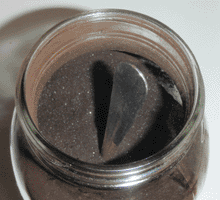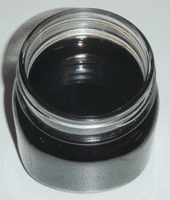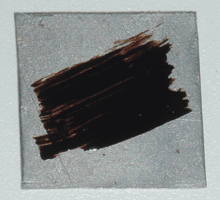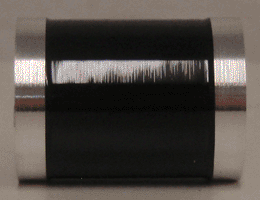



Asphaltum is a hard, glassy form of natural tar, and was commonly used in the past to make decorative and rust-proof coatings for iron and steel. One of the most durable coatings is a mixture of asphaltum and linseed oil, which can be made in the same way as the previous varnish. This type of coating dries poorly under ambient conditions, but if baked at high temperatures it forms a hard, glossy surface. Because of this need for baking, I consider it an enamel rather than a varnish, although the principle (resin in oil) is the same.
To make this type of enamel, I began by ordering a significant quantity of asphaltum powder from Renaissance Graphic Arts. In particular, this asphaltum is from a mineral called Gilsonite, which is mined in Utah and is generally regarded as the highest-quality asphaltum available. I then mixed one part of this asphaltum with an equal part (by weight) of boiled linseed oil and two parts of turpentine in a mason jar. I then heated the jar gently on a hot plate, and stirred the mixture until it became a homogeneous solution. I then let the jar cool slowly without disturbing it, as there was some insoluble grit contained in the asphaltum which I wanted to allow to settle.
Once the enamel solution had cooled, I began experimenting with it to determine the baking temperature. I painted small amounts on pieces of sheet steel, let the turpentine evaporate, then exposed them to increasing temperatures on my hot plate. Interestingly, I found that no significant hardening occurred until the temperature rose to at least 200°C. At 150°C the enamel would remain soft and gummy, even if baked for three hours, but at 220°C it would harden fully within an hour. The hardened films produced this way retained the gloss of the freshly painted enamel, but could not be scratched with a fingernail. They were also flexible enough to be bent, however, and in general this enamel seems to resemble the metal itself.
I then decided to paint a more complex object, and turned an aluminum cylinder with a recessed area to be enameled. I then painted it with a small artist's brush, making sure to achieve an even, opaque coating. Once the solvent had evaporated, I attempted to bake it on my hot plate, but found this to be unsuitable; I then baked it in a small convection oven at 200-250°C for an hour, at which point the coating had become hard and unscratchable. The results are highly visually appealing; the enamel conforms to the metal surface, and has no tendency to run or sag during either the painting or baking processes. Excess enamel can be machined off without chipping or tearing, leaving a clean edge; this property makes it highly suitable for painting castings or plaques. Overall, I am very pleased with the results, and will definitely use this type of coating in future projects.